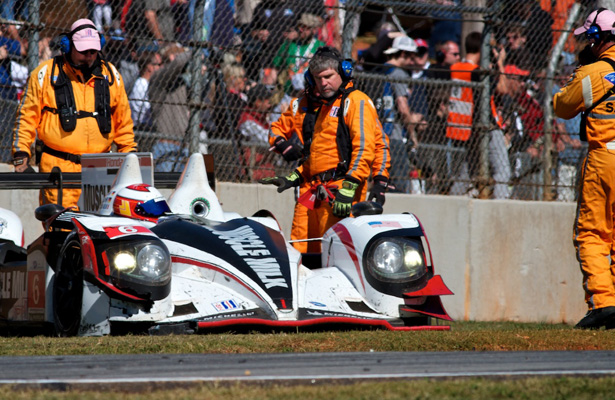
Photo: John Dagys
The merger between GRAND-AM and the American Le Mans Series has resulted in numerous changes, and in some cases, compromises, to the way each series had previously operated individually.
One of the hot topics over last weekend’s ALMS-ending Petit Le Mans was the future of IMSA’s traveling safety team, which has played an integral part of the series since its inception in 1999.
However, according to IMSA Safety Team Coordinator John Zilles, his crew was informed last week that changes are on the horizon for 2014, as the sanctioning body falls under the NASCAR umbrella.
Zilles indicated that track-specific local firefighters, EMTs and paramedics could be used in lieu of a full traveling rapid response unit in the TUDOR United SportsCar Championship and its various development series next year.
An IMSA spokesperson declined comment on this matter, stating that plans for the 2014 safety team have not yet been finalized.
“We’re really disappointed because we think that it’s short sighted and the overall patient care for our drivers are going to be compromised,” Zilles said in a Sportscar365 exclusive interview.
“I don’t think it’s ever going to be as good as it is when you have a full-time group of people who knows the cars, knows the drivers, knows the series and are there week in and week out. I just don’t think we can trust that same responsibility to a track that only sees them once a year and expect it to be as good as it is now.”
While NASCAR and GRAND-AM have relied on local safety workers, the ALMS, along with IndyCar Series and NHRA, have used traveling teams that have saved the lives of numerous open-wheel and drag racers in the last decade.
The issue appears to be patient care, as Zilles said the reason for the likely changes is due to risk management and the series’ insurance policies. Under NASCAR’s current safety team protocol, a liaison truck is used at all events, but series-employed officials are not allowed to extract drivers, he said.
Zilles said he was not aware of any risk management issues for the 23 years he has worked for IMSA under its various ownerships.
A number of drivers, both in the GRAND-AM and ALMS paddock, have spoken up regarding the possible changes.
“I’ve always been pretty vocal within GRAND-AM for the lack of familiar faces,” said Ryan Dalziel. “Being on the Champ Car side of it for a few years, there was nothing better than having a personal relationship with the guys that are the first responders.
“I think we need it. I think if you went to every team, we’re going to have 60 cars next year, and said it’s going to be $2,000 more per entry and for that $2,000, we’re going to get X, Y and Z. If that’s what it takes, I’d put the money in as a driver and I’m sure I’m not the only one that would do that.”
The topic came to a head during the drivers’ meeting at Road Atlanta, which saw several drivers and team principals speak up over potential future safety concerns, especially in light of the recent deaths of sports car drivers Allan Simonsen and Sean Edwards.
“What we have now works. To the greatest possible extent, we have to retain those elements in the new format,” said Chris Dyson. “Clearly, everyone in the IMSA paddock has been really fortunate to have the best safety team in the business. I think that all of us to a man agree that if it ain’t broke, don’t fix it. That’s certainly a sentiment that we vocalized during the driver’s meeting.”
One significant difference from NASCAR is the fact that sports car racing features a wide variety of machinery and technology.
With four different classes, including open-top prototypes and coupes even in the same class, built by different manufacturers, educating local EMTs on driver extraction for each type of car would be a challenge, said one driver who asked to remain anonymous.
A traveling team, Zilles said, also has its advantages when it comes to recognizing symptoms that may initially go unnoticed by a local EMT.
“We know the drivers and we know their personalities,” Zilles said. “We respond to incidents so quickly that we see the driver’s condition before it changes to something that you may not recognize if you don’t get there for another minute.
“We have recognized some concussions in some people that we knew well, simply because we saw personality changes after their accident. You really need to be there all the time. You need to know all of these guys and recognize us.”
Zilles said his team was informed that the structure of the safety team will not be finalized until the NASCAR season ends in mid-November. However, the longtime IMSA worker won’t be around to wait, as he’s decided to retire from his post.
Dyson, however, remains optimistic that a solution can be found.
“At the end of the day, Scott Atherton and Scot Elkins are IMSA guys and they know what’s worked for IMSA as an independent entity,” he said. “We’re now under the NASCAR umbrella and I think we have to take the best of both worlds. If they can do that, they might even move the game forward, who knows.”
“With the 2013 we had, I think safety needs to be a priority and I think we can do a better job,” Dalziel added. “You can’t rely on local paramedics. You can maybe rely on local hospitals and doctors but the guys that get to the car first, safety crews and first responders, are the most important people and they’re the ones that save lives.”

























